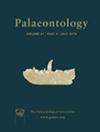将F放入FBD分析:树约束还是形态数据?
IF 2.3
2区 地球科学
Q1 PALEONTOLOGY
引用次数: 1
摘要
摘要:出生-死亡(FBD)化石过程为推断现存和化石分类群的系统发育提供了一个理想的模型。使用这种方法,化石被直接整合到树中,导致了统计上一致的分化时间先验。由于化石通常与分子序列无关,因此需要额外的信息来将化石放在树中。我们使用模拟来评估在FBD分析中处理化石放置的两种不同方法:使用拓扑约束,用户根据已建立的分类学指定单系进化枝,或者使用全证据分析,除了分子比对外,还使用形态学数据矩阵。我们还探讨了化石采收率或多样化率的变化如何影响这些方法。我们发现,在各种化石放置方法下,现有的拓扑结构都得到了很好的恢复。除了包含错误的约束外,散度时间在所有方法中都可以得到很好的恢复。我们在包含速率变化的数据集中看到了类似的模式,然而,对于所有使用拓扑约束的方法,特别是对于带有错误的约束,当数据集中包含更多的变化时,现有发散时间的相对误差会增加。最后,我们证明了在FBD模型下恢复的树木比使用非时间校准推理估计的树木更准确。总的来说,我们表明,即使包括不确定性,这两种化石放置方法也是可靠的。我们的研究结果强调了核心分类学研究的重要性,包括形态数据收集和物种描述,无论使用FBD过程处理系统发育不确定性的方法如何。本文章由计算机程序翻译,如有差异,请以英文原文为准。
Putting the F into FBD analysis: tree constraints or morphological data?
Abstract The fossilized birth–death (FBD) process provides an ideal model for inferring phylogenies from both extant and fossil taxa. Using this approach, fossils are directly integrated into the tree, leading to a statistically coherent prior on divergence times. Since fossils are typically not associated with molecular sequences, additional information is required to place fossils in the tree. We use simulations to evaluate two different approaches to handling fossil placement in FBD analyses: using topological constraints, where the user specifies monophyletic clades based on established taxonomy, or using total‐evidence analyses, which use a morphological data matrix in addition to the molecular alignment. We also explore how rate variation in fossil recovery or diversification rates impacts these approaches. We find that the extant topology is well recovered under all methods of fossil placement. Divergence times are similarly well recovered across all methods, with the exception of constraints which contain errors. We see similar patterns in datasets which include rate variation, however, relative errors in extant divergence times increase when more variation is included in the dataset, for all approaches using topological constraints, and particularly for constraints with errors. Finally, we show that trees recovered under the FBD model are more accurate than those estimated using non‐time calibrated inference. Overall, we show that both fossil placement approaches are reliable even when including uncertainty. Our results underscore the importance of core taxonomic research, including morphological data collection and species descriptions, irrespective of the approach to handling phylogenetic uncertainty using the FBD process.
求助全文
通过发布文献求助,成功后即可免费获取论文全文。
去求助
来源期刊

Palaeontology
地学-古生物学
CiteScore
5.60
自引率
3.80%
发文量
43
审稿时长
6 months
期刊介绍:
Palaeontology publishes a wide variety of papers on palaeontological topics covering:
palaeozoology
palaeobotany
systematic studies
palaeoecology
micropalaeontology
palaeobiogeography
functional morphology
stratigraphy
taxonomy
taphonomy
palaeoenvironmental reconstruction
palaeoclimate analysis and biomineralization studies.
 求助内容:
求助内容: 应助结果提醒方式:
应助结果提醒方式:


